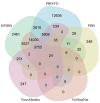Bioinformatics Goes Viral: I. Databases, Phylogenetics and Phylodynamics Tools for Boosting Virus Research
- PMID: 39339901
- PMCID: PMC11437414
- DOI: 10.3390/v16091425
Bioinformatics Goes Viral: I. Databases, Phylogenetics and Phylodynamics Tools for Boosting Virus Research
Abstract
Computer-aided analysis of proteins or nucleic acids seems like a matter of course nowadays; however, the history of Bioinformatics and Computational Biology is quite recent. The advent of high-throughput sequencing has led to the production of "big data", which has also affected the field of virology. The collaboration between the communities of bioinformaticians and virologists already started a few decades ago and it was strongly enhanced by the recent SARS-CoV-2 pandemics. In this article, which is the first in a series on how bioinformatics can enhance virus research, we show that highly useful information is retrievable from selected general and dedicated databases. Indeed, an enormous amount of information-both in terms of nucleotide/protein sequences and their annotation-is deposited in the general databases of international organisations participating in the International Nucleotide Sequence Database Collaboration (INSDC). However, more and more virus-specific databases have been established and are progressively enriched with the contents and features reported in this article. Since viruses are intracellular obligate parasites, a special focus is given to host-pathogen protein-protein interaction databases. Finally, we illustrate several phylogenetic and phylodynamic tools, combining information on algorithms and features with practical information on how to use them and case studies that validate their usefulness. Databases and tools for functional inference will be covered in the next article of this series: Bioinformatics goes viral: II. Sequence-based and structure-based functional analyses for boosting virus research.
Keywords: bio-databases; bioinformatics; computational biology; data mining; phylodynamics; phylogenetics; sequence alignment; virus evolution; virus–host interaction.
Conflict of interest statement
The authors declare no conflicts of interest.
Figures




References
Publication types
MeSH terms
LinkOut - more resources
Full Text Sources
Miscellaneous

